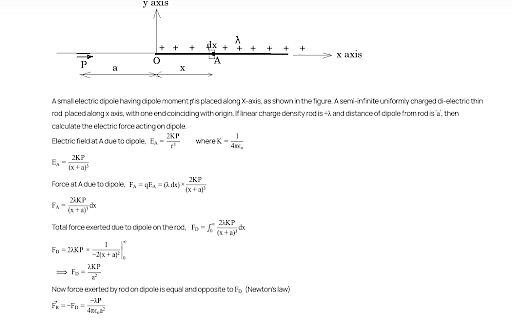Dipole placed in a sphere, what will be the electric flux?
Solution and Explanation
The electric flux through a closed surface is given by Gauss's law, which states that the total electric flux through a closed surface is equal to the enclosed charge divided by the permittivity of the medium.
If the dipole moment is aligned with the normal vector of the surface, the electric flux through the sphere will be zero. This is because the positive and negative charges of the dipole cancel each other's contributions to the electric field at every point on the surface, resulting in no net flux passing through. If the dipole moment is not aligned with the normal vector of the surface, the electric flux through the sphere will be nonzero. In this case, the positive and negative charges of the dipole do not cancel each other completely, resulting in a net electric field passing through the surface of the sphere. This net electric field will lead to a nonzero electric flux through the sphere.
Therefore, the electric flux through the sphere with a dipole inside will depend on the orientation of the dipole relative to the surface of the sphere.
Top Questions on Electric charges and fields
The magnitude of heat exchanged by a system for the given cyclic process ABC (as shown in the figure) is (in SI units):

- JEE Main - 2025
- Physics
- Electric charges and fields
- What is the difference between an open surface and a closed surface?
- CBSE CLASS XII - 2025
- Physics
- Electric charges and fields
- A small spherical shell \( S_1 \) has point charges \( q_1 = -3 \, \mu C \), \( q_2 = -2 \, \mu C \) and \( q_3 = 9 \, \mu C \) inside it. This shell is enclosed by another big spherical shell \( S_2 \). A point charge \( Q \) is placed in between the two surfaces \( S_1 \) and \( S_2 \). If the electric flux through the surface \( S_2 \) is four times the flux through surface \( S_1 \), find charge \( Q \).
- CBSE CLASS XII - 2025
- Physics
- Electric charges and fields
As shown below, bob A of a pendulum having massless string of length \( R \) is released from \( 60^\circ \) to the vertical. It hits another bob B of half the mass that is at rest on a frictionless table in the center. Assuming elastic collision, the magnitude of the velocity of bob A after the collision will be (take \( g \) as acceleration due to gravity):

- JEE Main - 2025
- Physics
- Electric charges and fields
- A particle of mass \( m \) and charge \( q \) is fastened to one end \( A \) of a massless string having equilibrium length \( l \), whose other end is fixed at point \( O \). The whole system is placed on a frictionless horizontal plane and is initially at rest. If a uniform electric field is switched on along the direction as shown in the figure, then the speed of the particle when it crosses the x-axis is:

- JEE Main - 2025
- Physics
- Electric charges and fields
Questions Asked in BITSAT exam
- Find the derivative of \( y = \sin(x^2) \) with respect to \( x \).
- BITSAT - 2025
- Fundamental Theorem of Calculus
- Find the equation of the tangent to the curve $ y = x^3 - 3x + 1 $ at the point where $ x = 2 $.
- BITSAT - 2025
- Tangents and Normals
- A box contains 5 red balls and 3 blue balls. If two balls are drawn randomly without replacement, what is the probability that one of the balls is red and the other is blue?
- BITSAT - 2025
- Probability
- If $ f(x) = x^2 + 3x $, then $ f'(x) $ is:
- BITSAT - 2025
- Quadratic Equations
- Evaluate the sum: $$ \sum_{n=1}^{\infty} \frac{1}{n(n+1)(n+2)} $$
- BITSAT - 2025
- Fundamental Theorem of Calculus
Concepts Used:
Electric Dipole
An electric dipole is a pair of equal and opposite point charges -q and q, separated by a distance of 2a. The direction from q to -q is said to be the direction in space.
p=q×2a
where,
p denotes the electric dipole moment, pointing from the negative charge to the positive charge.
Force Applied on Electric Dipole
